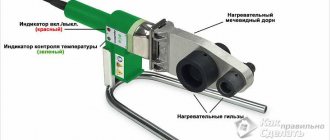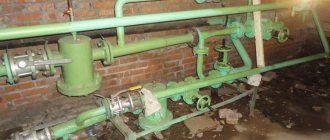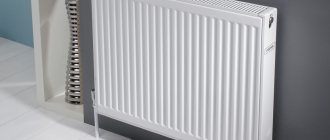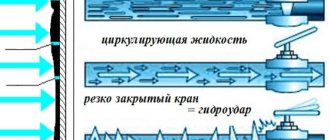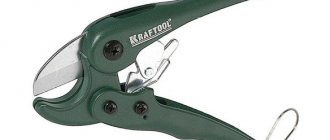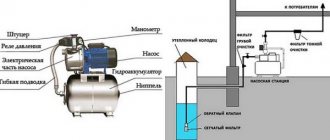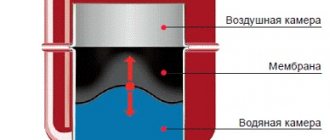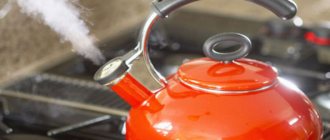The formation of an air lock in the heating system is characterized by partial cooling of radiators or sections of water-heated floors. Sometimes a murmur can be heard in pipes and radiators, indicating the location of accumulated air. I’m interested in 2 questions: how to remove it from there and prevent similar troubles in the future. We propose to consider the reasons for airing of heating devices in private homes, and then we will suggest ways to remove air bubbles from the heating network.
Causes
Residents of high-rise buildings had to deal with an unpleasant situation when the heat on the top floors did not reach them at the start of the heating season . There are several reasons for air congestion:
- repair work, such as pipeline dismantling;
- during installation, the slope directions and dimensions of the pipelines were not observed;
- low pressure;
- error when filling the heating system;
- poor sealing of joints - coolant leaks through them;
- connection to underfloor heating;
- malfunction of air intake devices.
In this video you will learn how to remove air from a radiator:
If you live in a private house, you shouldn’t worry too much about a little airiness in the system. The coolant in it is rarely changed, therefore, the air bleeds out on its own after one or two days.
Algorithm for cleaning the radiator
- We remove all unnecessary things and furniture from the heating radiator that may interfere with or delay flushing. If there are curtains hanging near it, you need to remove them. In addition, if the room uses laminate or parquet as flooring, then it is necessary to spread some piece of fabric or film under the radiator - this is done so as not to harm the floor.
Before starting work, you must turn off all taps
It is necessary to shut off the water supply to the radiator. If there is no shut-off valve that allows this to be done, then you will have to go the other way - drain the water from the heating system. Take a regular bucket, remove the radiator by unscrewing it from the rest of the equipment, and drain the water present in it into the prepared bucket. The cleaning process is just beginning and then you need to take the heating radiator to the bathroom and then place it in the bathtub. There is a risk of causing mechanical damage to it in the form of scratches, and in order to prevent such a development of events, place something like a wooden pallet under the radiator. If you live in a private house and not in an apartment, then to flush the radiator you will need to take it out into the yard.
The end fittings are unscrewed using a wrench
We unscrew the end fittings using a wrench. This must be done in the yard or in the bathroom, otherwise you can fill the floor with a cloudy and littered liquid that has a very unpleasant odor, and you will create another problem for yourself - you will need to clean the floor.
We recommend: White residue from a humidifier: what is it and how to deal with it, reasons
Next, you need to rinse the heating radiator from the inside; to do this, we supply water under pressure from a hose or shower into the holes at the end.
- Sometimes owners are forced to deal with crystalline blockages, and in this case slightly different means are needed. You can't do without a concentrated vinegar solution. We install the end fittings at the bottom and pour vinegar inside. Before using vinegar, it is recommended to dilute it 70% with water. This flushing will help remove stubborn blockages from the heating radiator. The solution should sit for about two hours, after which it should be poured out and the radiator should be cleaned with water pressure to achieve complete cleansing.
- You can also wash the external surfaces of the radiator to give it a nice and clean look.
One of the reasons for clogging may be scale formation
The radiator should be placed on wall mounts and the threaded connections on it should be lightly cleaned with a cloth, which must be dry. If you have a cast iron radiator, then screw tow onto all the fittings in the direction of the threads and apply paint to the seal. It is allowed to use any paint related to “Nitro” and “Enamel”. Using a two-piece gas wrench, tighten the fittings tightly. If the apartment has more modern radiators, then it is recommended to use film for waterproofing purposes. Do not use tow or paint.
So, as we see, there is nothing overly complicated about cleaning the radiator. This will not require any special skills or knowledge, just as you will not need any rare means and tools that are difficult to obtain. If done responsibly, this procedure will not take too much time and effort, and therefore every owner can clean the radiator on their own. However, there are situations where even after all the measures have been taken and the radiators are installed in their place, the heating system still functions poorly. In this case, you need to buy a new radiator and replace the old one, or use the services of specialized companies that carry out cleaning with a technical booster.
Bottom filling with user access
A distinctive feature of the bottom filling is the pairwise connection of heating risers. In this scheme, the supply and return bottlings are located in the basement of the building, and valves are located between them with risers. Either plugs or taps are installed behind the valves, allowing water to be drained if necessary.
During lower filling, the air present in the risers of the system is squeezed out into the upper sections of the risers connected in pairs. On the top floor (usually in apartments, but sometimes in the attic) there is a jumper between the risers, near which a Mayevsky valve is installed, which allows air to bleed from the system.
First of all, residents of apartments on the upper floors need to know how to remove an air lock from a heating system:
- The tap turns 180 degrees and air begins to hiss out of it;
- When water starts flowing from the radiator, the tap must be closed.
When living on any other floor, it will be enough to ask the neighbors above to bleed the air in their free time. If for some reason it is not possible to come to an agreement with the neighbors, you will need to submit an appropriate application to the local housing organization. The main thing is to ensure that the application is accepted in accordance with all the rules, and then if problems arise with heating, it will be possible to request a recalculation in the future.
Methods for cleaning heat pipes and radiators
In order to properly eliminate air pockets or scale, it is permissible to use several methods, the main ones are given below:
- hydraulic;
- individual;
- using soda ash;
- pulse;
- chemical.
Let's try to figure out what is their difference from each other.
Hydraulic method
Perhaps this is the most effective and at the same time the most expensive method. To implement this you will need an air compressor. With its help, an air-water mixture is pumped into the riser. High pressure creates a situation that leads to scale separation from the walls of the pipe or radiator. This cleaning method is most effective for cast iron radiators. Hydraulic cleaning does not require the use of any chemicals and can rightfully be described as environmentally friendly. But to properly clean the batteries, the homeowner must disconnect the batteries and take them to a specialized service center that has such a compressor. And then the question of how to properly blow out heating radiators will be taken off the agenda. When using this method, it is permissible to use softening agents. To remove traces of them, simply rinse the radiator with clean water.
Individual cleaning
It is advisable to carry out the hydraulic cleaning method when all the neighbors in a city (apartment) building have nothing against such work and are ready to participate in cleaning the heating system, and before blowing out the radiators in the apartment, you will have to coordinate this issue with them. Otherwise, all cleaning will go down the drain. And at the beginning of the heating season, the pipes and radiators will clog again.
If the homeowner does not want to communicate with the neighbors, then how to vent the heating radiator in the apartment? Individual cleaning can and should be done. To do this, you need to dismantle the radiators and wash them in the bathroom. The washing procedure is simple. To perform this, the battery must be disconnected from the network and transferred to the bath. Hot water must be supplied to one hole, and the battery must be constantly turned over. For greater effect, it is permissible to use a plumbing cable with a brush. Flushing is completed when more or less clean water begins to flow from the radiator.
Flushing a heating radiator using caustic (technical) soda
Caustic soda
The procedure for washing using technical soda is practically no different from that described above. The only thing is that all the holes in the radiator are plugged except one. Boiling water is poured into it and soda is added. After this, the radiator can be left alone for a certain time.
The use of technical soda causes the plaque inside the pipes and radiator to become soft and fall off the walls. To speed up the process, you can use a rubber or ceramic mallet. You can tap it on the battery case. This procedure is continued until clean water comes out of the battery. By the way, instead of technical soda, it is permissible to use special cleaners used for flushing the radiator installed in a car.
Pulse flushing
This method can only be used if you have a special gun. The technological capabilities of this device make it possible to use it for flushing a heating radiator with a distance between the walls of no more than 150 mm. In addition, it is permissible to remove scale at a distance of 50 meters.
Is specialized equipment really necessary? To decide on the purchase of equipment that can be used for cleaning radiators, one must proceed from how often it will be used for its intended purpose. The fact is that this work is carried out once a year, before the start of the heating season, and it is advisable to contact a special service.
On the other hand, cleaning the heat supply system yourself ultimately leads to saving money on calling a service company. In this case, you can buy a specialized pump and its accessories and flush the system yourself. When purchasing such equipment, you must pay attention to the following parameters:
- operating pressure;
- water consumption;
- setting the pulse frequency;
- possibility of using additional detergents.
Chemical washing
In many apartments, the quality of the heating system is far from perfect. Heating radiators, pipes, fittings have long been clogged with scale and the described methods are not enough to eliminate it. In this case, cleaning using chemicals comes to the rescue.
The chemicals used are usually organics, alkalis or solvents. When working with them, you must strictly follow safety regulations, because... these substances are mostly toxic.
But the chemical method has a limitation - it cannot be used for washing aluminum products. This may lead to a violation of their tightness. But, on the other hand, chemistry is very effective when working with cast iron batteries. Before blowing through the battery, it is advisable to check what metal the heating radiators are made of.
To perform work using chemicals, only specialized equipment should be used.
Home heating systems sometimes need cleaning. You can clean both entire pipes and individual parts. It is important for residents of private houses and owners of autonomous heating cycles to know how to bleed the battery themselves.
Feeling the batteries
Bottom Filling with Administrator Access - Air Lock Removal
It’s one thing if the problem can only be solved from your own apartment or by contacting specialists. It’s another matter if you can play the role of a specialist yourself, for example, by gaining access to the basement.
The solution to the problem in this case is as follows:
- Before removing air from the heating system, it must be bypassed, for which the heating valve is first closed and the sewer discharge located underneath is opened;
- After completing the previous steps, the system should be given about 5-10 minutes to release air;
- If the desired effect is not achieved, the system must be turned in the opposite direction;
- After bleeding the air, you need to close the vent and return all valves to their original positions so that the heating circuit continues to function as normal.
Individual risers with which problems have arisen can also be transferred from the basement level. To do this, it is enough to close the valve of one of the connected risers and open the discharge. The probability of successful bleeding of air in this case is quite high, and if one of the risers is used as an idle pipe, then the work will certainly be crowned with success.
Even if plugs are installed on the risers instead of vents, there are a couple of ways to get rid of an air lock in the heating system:
- The first option is to shut off both risers, reset them, and then replace one of the plugs with a ball valve with a male-female thread. Of course, this option will require the faucet itself - but its cost is low, and such costs are certainly worth it so that the heating system can continue to operate.
- For the second option, you need to close the valves located on the risers, and then unscrew one plug. The riser is put into reset mode, stops, and then the previous operations are repeated in reverse order. This method of bleeding air can only be used when the coolant temperature is below 45 degrees - otherwise the person performing this work may be seriously burned.
What to do
- Remove paint from the side plug. Any tool with a sharp edge (screwdriver, knife) and solvent available in the house will help.
- Place a container under the radiator to collect water.
- Cover the adjacent wall with polyethylene film or other moisture-repellent material.
- Using a gas wrench, carefully try to remove the plug from its place. It must be remembered that cast iron is both strong and brittle. If this does not work, treat the threaded connection area with WD-40. Just spray it from a can and wait 15 minutes; the aerosol will literally eat away all deposits and rust. After this, the plug will come out easily. But do not forget that you need to unscrew it gradually - there is residual pressure in the system.
- After water appears, the plug is put in place. To prevent the thread from “souring” in the future and causing problems with air bleeding, you should wrap FUM tape around it, and before painting, apply a thin layer of lubricant to the joint.
Top filler with administrator access
If the building uses top filling, this means the following: the coolant supply point is in the attic, and the return circuit is located in the basement. With this configuration, the risers are connected from below and from above, while having the same functional load, so the system maintains an equal temperature within the same floor.
When the circuit is started, air from the radiators moves through the risers into the supply line, and then enters the expansion tank located at the top of the system. Before you bleed air from the heating radiator, you will first need to open the house valves, then go out into the attic and open the tap built into the tank. After some time, the air will simply be squeezed out of the system, and the coolant can continue to circulate calmly. Read also: “How to bleed air from a heating radiator correctly - theory and practice.”
Briefly summarizing, we can say the following - in the absence of experience and understanding of how the heating system works in an apartment building, it is better not to think about how to bleed the air from the radiator yourself. For example, when filling from above, there is a considerable risk of flooding of apartments located on the upper floors, so it is better to entrust such work to specialists from a housing company.
How to bleed air from batteries in a private house
In private homes, a situation may also arise in which air appears in the heating system. What is important is not how the heating system in a private house is aired, but how to get rid of unnecessary air. There is no universal solution to this problem - the heating of a private house is usually designed individually, so the assembled structure has a lot of its own nuances.
However, all types of heating systems have similar features that need to be studied before bleeding air from the battery:
- If the heating has forced circulation, then special air exhaust elements are always installed near the pump (as a rule, they are located either in front of the pump or directly in the boiler). Air in the system in the presence of such elements is most often due to their clogging.
- Air vent valves can also be installed directly on batteries, but only if they are located above the filling point. If the bottling is located somewhere at the upper level, then the air valve should be looked for at its highest point.
- All vertical bends of the filling have their own air vents. If they are absent, you will have to use one of the methods described above to bleed air.
Before you bleed the air from the battery, you need to make sure that the heating system is started correctly - sometimes the reason for its stopping is a valve that is closed in one of the sections.
Why does air accumulate in water heating radiators?
There are no questions about the appearance of air inside radiators when the heating elements have just been installed new or have undergone major repairs. It is more difficult to find out where the air pockets come from during intensive use of the system. The reason for this is often installation or operating errors.
If we cover all cases of a problem, then air appears in the heating for the following reasons:
- the gravity system does not have a pipe slope;
- the battery is not positioned on the brackets at a strictly horizontal level;
- Filling of water into the heating system was performed incorrectly;
- depressurization of components, poor connection of some heating elements;
- lack of automatic air bleeding or its breakdown;
- carrying out minor repairs to a separate unit, resulting in depressurization of the system;
- accumulation of a large amount of rust inside the battery sections;
- Filling the autonomous heating with a new portion of water containing a large admixture of air.
Violation of the horizontal position of the battery will lead to its frequent airing.
It is difficult to find out why air appeared inside the battery. However, knowing them, it is worth taking measures in advance aimed at reducing the likelihood of heating heating.
Safety precautions and preventive maintenance
To avoid injuries and other problems, you need to follow a number of rules when bleeding air:
- The rod from the air valve cannot be unscrewed - the pressure of the heated coolant will not allow it to be screwed back on;
- The body of the tap also cannot be turned out - it is very easy to break the thread, but it is difficult to eliminate the consequences of flooding the apartment;
- The radiator caps cannot be unscrewed even partially - they cannot be returned later, and boiling water pouring out of the radiators will bring a lot of negative emotions (about
How long do you need to bleed the batteries?
The duration of the procedure is determined individually. It all depends on the scheme, type of heating, degree of airing. Usually the process is considered complete when the air stops hissing from the tap and the water flows in a steady stream.
The deaeration process is considered complete when water flows steadily from the tap.
To confidently remove the air lock in the heating battery, drain 3 buckets of water through the tap. With this amount of coolant, all the air is guaranteed to escape.
What can an airy heating system cause?
Which radiators to choose for heating a private home - read on.
Useful article about air purifiers here.
How to calculate the number of sections of bimetallic heating radiators for a home? https://klimatlab.com/otoplenie/radiatory/bimetallicheskie-kak-rasschitat-kolichestvo-sekcij.html
The result of such an air lock is a decrease in the service life of the radiator, and if an autonomous heating system is used, the shaft bearings break, followed by the pump, since the boiler has to distill air instead of water.
How to avoid air locks
It is impossible to completely 100% eliminate the formation of air locks even in modern heating. But you can reduce the likelihood of their formation if you follow a number of rules.
When heating is installed according to the correct design, airing rarely occurs
First of all, you need to correctly install all heating devices and select the optimal heating scheme for a particular building. The batteries are placed strictly horizontally. The pipeline is laid with slopes. Each radiator is equipped with a Mayevsky valve or automatic air vents are installed. Moreover, the unit is additionally installed in difficult sections of the pipeline, where there is a risk of plug formation.
Water is added to the autonomous system through the return line. To do this, a fitting with a shut-off device is provided at the bottom point of the circuit. If the autonomous system is of an open type, the water level in the expansion tank is constantly maintained.
Types of air vents
The air vents themselves are divided into automatic and manual. In the case of tame ones, they are also called Mayevsky. They have small dimensions and are placed on the end parts of the heating system. The tap is adjusted using a key, while others do it manually. Of course, small size affects performance. Mayevsky's crane is suitable only for local removal of air jams.
Automatic options work without human intervention. They can be installed horizontally or vertically. The performance is quite high, but there is also a significant drawback - increased sensitivity to pollution. In this regard, their installation is carried out immediately with filters for reliability.
Automatic air vents are installed according to a certain pattern: along a line of pipes at several different points. It turns out that air is released separately from each group. This multi-stage deaeration system is called the most effective. If the pipes are laid correctly, there will be no problems with air removal.
Cost of manual and automatic air vents
Prices for air vents for heating systems depend mainly on the metal from which they are made, the manufacturer and the size of the valve. The cost of an automatic air vent can range from several hundred rubles to several thousand for imported devices.
Comparative table of prices of main types and modifications.
| Air vent nomenclature | Cost in regions, retail price, rub/piece, excluding VAT | Cost in Moscow, retail price, rub/piece, excluding VAT |
| Automatic Broen Ballofix (Spain) | 395,00 | 373,00 |
| AE32-17 automatic DN 25 (DN 1) PN40 f | 49 850—50 400 | 49 350 |
| Air bleeder Navien pump Deluxe 13-40K, Deluxe Coaxial | 1000—1200 | 890—1000 |
| Manual air vent FHF-EM (Danfoss) | 710—740 | 705 |
| Manual air vent, simplified | 12,00—15,00 | 11,50—12,50 |
| Manual air vent, 15, for screwdriver | 19,75-22,00 | 18,00—20,00 |
Humidifiers
During the heating period, it is recommended to maintain the indoor humidity necessary for normal living. For this you need humidifiers.
You can make them yourself. There is a lot of information on the Internet to implement this idea. Otherwise, radiator-mounted air humidifiers can be purchased and installed yourself. You can find out how to bleed air from the battery by following this link.
How to avoid air locks
If the heating main is made in accordance with the requirements of GOST and TU (technical conditions), then the appearance of air masses in it is minimized. Another condition to prevent this phenomenon is the correct process of filling the system with water. It has its own characteristics for open and closed heating circuits.
Open circuit
The diagram of an open heating circuit gives an idea of the order in which such a system should be filled with water after flushing. At its highest point there is an expansion tank, and in it there is a special pipe. Its purpose is to protect the highway from overflow.
Such a contour is filled in as follows:
- At the lowest point there is a shut-off valve, through which cold coolant is supplied to the circuit.
- The heating boiler is switched off before filling the system.
- After this, filling of the contour begins. The incoming valve at the bottom of the circuit opens in such a way that the coolant flows in very slowly. In numerical terms, this is expressed in a ratio of 1:3. This means that the valve only needs to be turned back one third of the inlet diameter of the pipe.
- Filling continues until the coolant flows through the overflow hose. Then the water tap is closed.
- Then, air vents are opened on all radiators to ensure high-quality filling of the system.
- The boiler is reconnected. It is advisable to open its taps very slowly.
- The next step is to add coolant at the same slow pace, with the expansion tank filled to 60-70%.
- The operation of the heating system must be checked.
- The boiler is turned on for heating.
- Radiators and pipes are inspected to identify areas where there is no or low heat. This indicates a blockage in the heating line.
- Having identified the cause of airing, the procedure is repeated.
In the first week after connection, the operation of the system is carefully monitored: the water level in the expansion tank, as well as the condition of the radiators and pipes. If necessary, this will allow problems to be resolved quickly.
Filling closed systems
In a similar way, a closed type system is filled with coolant. Water is also supplied to it in a slow flow through a special tap. You can fill the heating system with water yourself.
You should proceed according to the following scheme:
- To perform the procedure, you need a device to measure pressure in the system - a monometer.
- The supply of coolant into the pipeline begins.
- At the same time, pressure is monitored. When it reaches just over 1.5 bar, the supply is turned off.
- Now you can bleed air from all radiators through air vents. In this case, the pressure in the system should begin to decrease.
- The coolant is added in doses to the circuit to maintain it at the required level.
- When the air is completely bled and the line is filled with coolant, the pressure must correspond to the norm. It depends on the specific equipment - from 1.5 to 2.0 bar.
It is optimal to fill a closed contour together with an assistant.
Technology:
- The first bleeds air masses from the radiators.
- The second controls the pressure level in the heating system. If necessary, adds or reduces the feed intensity.
- The first gives a signal about the release of air from the system.
- The partner brings the pressure to the set value.
- The supply stops.
Design and types of Mayevsky crane
- cone-shaped needle valve. When it is closed, the water is successfully retained in the battery. An open valve releases air that has accumulated inside the system;
- adjusting screw - a part with which the needle valve opens and closes;
- square wrench - needed to be able to turn the adjusting screw. However, in the absence of a special device, you can get by with a regular screwdriver;
- the housing in which the needle valve is hidden. It is generally made from alloys using brass, which gives it excellent anti-corrosion properties.
These elements form the basis of the design. But there are some differences inherent in certain varieties. In general, Mayevsky cranes are divided into three groups: manual equipment, automatic and with a built-in fuse. Let's take a closer look:
- manual is the same simple design described above. If necessary, turn the adjusting screw using a screwdriver or a four-sided wrench, the air is released, then the screw is screwed back in. The device is absolutely simple and reliable;
- There is no needle valve in an automatic faucet; the role of this part is played by a float made of plastic. There is also no manual control system as such, but if necessary, you can still adjust its operation manually. The principle of operation is quite simple: inside the brass body there is a float that moves depending on how much air has collected in the system. When moving, it opens the shutter. The air is released through the latter. Then the float rises back, thereby blocking the corresponding hole;
- a device with a fuse not only rids the system of excess air, but also controls the pressure in it. If this indicator increases to 15 atmospheres, a special valve in the equipment is activated, through which the excess is released. It is optimal to install such a device on pipes made of metal-plastic or polypropylene, since they themselves do not withstand too high pressure.
Article on the topic: How to lay tiles on a wall: step-by-step debriefing from an experienced master
To choose the device that is most suitable for your case, you need to take into account some nuances, in particular the type of heating. If it is centralized, then it makes sense to install only a manual Mayevsky crane. As a rule, the water in such heating systems is very dirty, so automatic types of equipment will either quickly fail or require constant cleaning.
But for private homes, automation is perfect, because there the quality of water in radiators is at a completely different level. In addition, the crane will automatically save the situation in cases where it has to be installed in a hard-to-reach place: for example, in a niche whose walls will not allow access to the manual control screw.
For old cast iron batteries there is also a special Mayevsky crane with a manual control system. But the best option is to install a brass air vent with an automatic operating principle. Such products are highly durable and easy to use.
Places of formation and elimination
It is necessary to bleed air from the battery if there is no doubt about its presence. Gasping is indicated by unexpected gurgling sounds. In addition, the owner begins to notice that the heating is uneven. To restore radiator circulation, air must be removed.
If the system is completely aired, first determine where the plugs are forming by tapping the pipes with a hammer. The sound is stronger and more sonorous in the places where the traffic jam occurs; the areas will also have a lower temperature. Having found a place with air, you need to do the following:
- Prepare a key or screwdriver, as well as a basin for water. The thermostat is opened to the maximum level, then the container is placed.
- Open the valve, making sure that all the water from the inside will flow into the substituted container. You can additionally place rags around.
- The valve must be kept open until all the liquid has drained. A slight hiss indicates air escaping. This means that the manipulations are performed correctly.
- If after the procedure the pipes still do not heat up well, then they need to be blown out and washed - the accumulation of rust inside can also cause air to appear.
Filling the system correctly
The easiest way is to pump water or antifreeze into pipelines connected to an open expansion tank. To do this, you need to open all the valves (except for the drain) and, by attaching a hose to the make-up fitting, fill the lines and radiators with coolant. In this matter, it is important to take your time and allow the air to leave the system on its own through the expansion tank.
Advice. After filling, turn on the circulation pump and boiler, and then warm up all heating devices. Then release the remaining air from them through the Mayevsky taps. Do not forget to bleed the pump before starting, as described above.
Now about how to bleed air from the radiators and pipelines of a closed heating system in a private house. The proposed technique, constantly practiced by our expert, plumber Vitaly Dashko, is performed in the following order:
- Open all shut-off valves of the main circuits (except for the drain).
- Close all radiator valves, excluding the very last batteries at the ends of the loops, so that circulation occurs through them.
- Get an assistant to do the work. Its task is to be in the boiler room and maintain the pressure in the network at a level of 1 bar using a pressure test pump or through a feed branch from the water supply.
- After opening the water supply, fill the main lines, expansion tank and boiler tank. Air must be released through the safety group valve and air vent at the highest point (if equipped).
- Go to the first radiator from the boiler and open both taps at the same time (slowly). Bleed the air through the Mayevsky valve and close the valves again. The assistant at this time does not allow the pressure to drop below 1 bar.
- Repeat the operation on all batteries, then turn on the circulation pump and start the heat generator. When the lines begin to warm up, open all the radiator valves one by one and remove any remaining air from them again.
Important point. Before squeezing air plugs out of radiators, be sure to bleed the air from the circulation pump and turn it on for 5-10 minutes to bleed the pipelines.
After the heating devices have completely warmed up, the pressure in the system should be in the range of 1.3-1.6 Bar. At this point the procedure is considered complete. If the system contains heated floors, then they should be filled last, using the same algorithm (on cold floors!). That is, having pumped up the pressure in the main line, you need to alternately open and close the floor circuits, bleeding air through the manifold valves, and then warm up and adjust the coolant flow.
Note regarding the installation of automatic air release valves. Such a device should always be in the boiler safety group, and the second, third, and so on - only when the lines pass above the radiators. With lower wiring in a one-story house, air accumulates in the radiators, since they are located above the pipelines, and it is not necessary to install valves on them.
Advice from professionals
A few tips from professionals will help you safely ventilate the system and reduce the likelihood of blockages:
- Always add water to the cooled autonomous heating circuit from the lowest point under low pressure. After topping up, turn on the boiler, heat the coolant to a temperature of 60 °C, and begin to bleed air from each battery through the Mayevsky valve. If necessary, after servicing all radiators, add more water to the system.
- The rod from the Mayevsky tap cannot be completely unscrewed. It is difficult and often impossible to screw it back in under running hot water.
- Unscrewing the radiator cap in an apartment is strictly prohibited. Central heating operates under high pressure. If the plug is torn off, all the apartments below will be flooded.
If problems arise with airing, it is best to call a specialist from a service organization who has the right to turn off the riser for repairs even during the heating season.
How to understand that the battery is airy
Signs of air locks appear immediately. Here you don’t need to be a great specialist to understand that it is necessary to get rid of air in the heating radiator by bleeding it.
Cold areas of the battery indicate the presence of air.
You can recognize the airing of the heating by the following signs:
- Air serves as a kind of heat insulator. In the place where it accumulates inside the battery, the sections are not heated by the coolant. The areas can be easily identified by touching the radiator with the palm of your hand.
- The presence of air will be indicated by gurgling in the radiators when the heating is on.
- Autonomous heating of a closed type is equipped with a pressure gauge. If the measuring device shows a drop in pressure in the system, then it does not occur without a special reason. Probably, a leak appeared somewhere due to depressurization of the unit. Naturally, as the coolant flows out, air penetrates into the system.
If one of the reasons appears, you need to bleed the air from the radiator in the apartment, after which the heating will be restored.
Important! The reason for the battery cooling may be that one of the supply pipes is clogged with rust or dirt. If, when draining from the Mayevsky tap, a strong stream of water flows without pops of air, then the problem is not airing.
